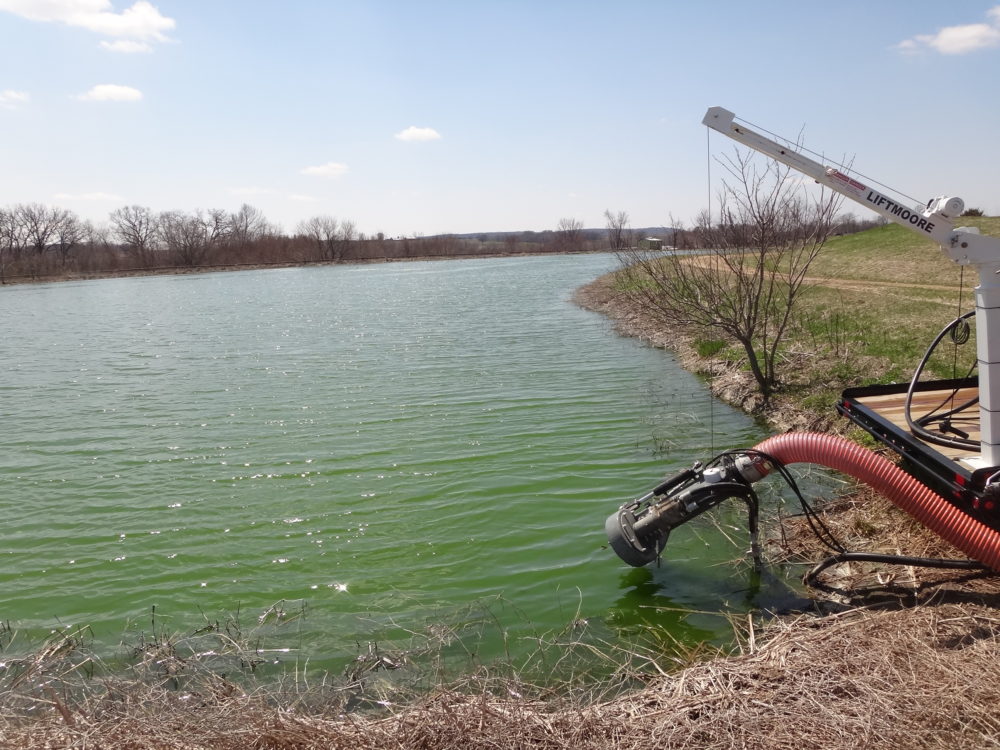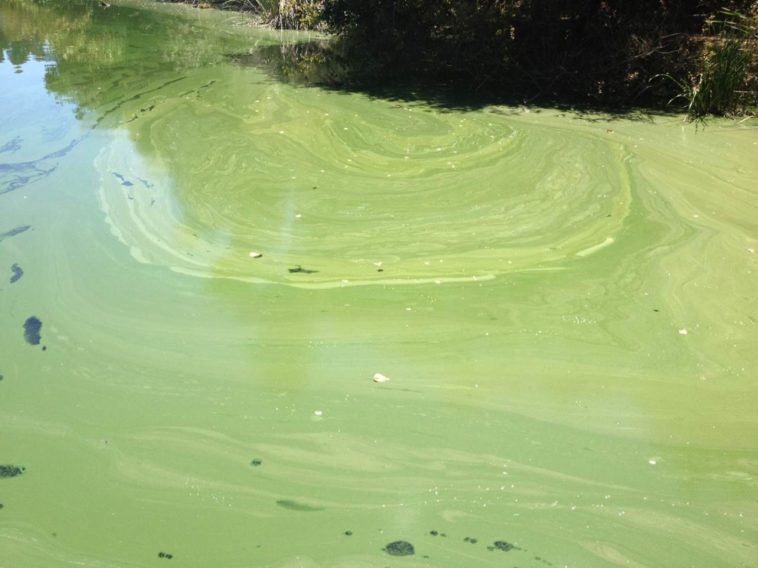How to Get Rid of Algae in Dams
This article provides a basic overview of how to identify the algae in your dam, and details a handful of methods that can be used to tackle your algae problem. For a more detailed article on all the options available to combat your algae—ranked in order from most effective to least effective—read our article: 10 Ways to Get Rid of Algae from a Dam. It’s far more comprehensive.

Algal blooms are one of the most common issues that dam owners run into. Algae can seem to pop up overnight so it’s no wonder that you’re scratching your head and wondering how you’ve fallen foul of the algae gods.
Luckily, algal blooms tends to be a symptom of an underlying issue, not a fully fledged problem in their own right, so once you identify what is causing your algae outbreak, it is fairly easy to rectify.
In this article we’re going to walk you through the different types of algae and how to effectively combat them.
What are the different types of algae?
In order to properly treat algae, you must first understand what it is, and why it has appeared. Although in rare circumstances you may end up with a combination of varieties, your algae bloom will generally fall into one of the below categories:
Filamentous algae
Characterised by green “mats” or “clumps” on the surface of your dam, Filamentous Algae is the most common variety.

Often referred to as “string algae” this type of growth is generally experienced when you add direct sunlight and warmer temperatures to a dam that has an excess nutrient load.
Although mostly harmless, Filamentous Algae isn’t very pleasant to look at and if you allow too much to accumulate, it can suffocate your ecosystem and foul your equipment.
Planktonic algae
Planktonic Algae is not always immediately recognised as an algal bloom due to the way in which it manifests.
Those experiencing a Planktonic Algae outbreak will notice that their dam has turned green, with the shade progressing from a light discolouration in the instance of a mild bloom, through to a full, “pea soup” appearance in more severe cases.
Planktonic Algae appears for much the same reason as Filamentous Algae but with one key difference: Planktonic Algae has the ability to lay dormant and appear literally overnight, whereas Filamentous Algae with creep up on you over time.

Blue-green algae
Blue-green algae is by far the most concerning type of algae you can get in your dam. Characterised by a slick across the surface of the dam that appears most commonly in a blueish-green colour (hence the name), this toxic cocktail can spell disaster for your dam, livestock and wildlife and possibly even your family.
 Because of this, Blue-green algae must be treated very carefully in order to avoid stressing it, as stress is what causes it to release all of those toxins into your dam.
Because of this, Blue-green algae must be treated very carefully in order to avoid stressing it, as stress is what causes it to release all of those toxins into your dam.
The most important thing to understand about Blue-green algae is that it isn’t, in fact, algae at all. Although this is the common name attributed to it, you don’t get Blue-green algae in dams, you get Cyanobacteria outbreaks. This is what makes this type of infestation so dangerous as not only do Cyanobacteria steal nutrients and oxygen from other living creatures within your aquatic ecosystem, they also produce Cyanotoxins which are harmful to aquatic and terrestrial species alike.
How to get rid of algae in dams
As mentioned above, we recommend you read our article: 10 Ways to Get Rid of Algae from a Dam for a more comprehensive list of ways to get rid of algae. Below is a shortened list of ideas.
Option 1: Manually Remove The Algae
Sometimes the best way to deal with an algae outbreak in your dam is to simply remove it.
This method should be applied to small invasions of Filamentous Algae.
By manually removing the algae from your dam, you are getting rid of its immediate ability to spread and therefore reducing the chances of ending up with nasty green mats all over the surface of your dam.
It is important to note that this a quick fix for getting algae out of dams, not a long term solution for preventing algae from growing in dams. For a long term solution, please see option three below as nutrient reduction is the only consistent (and preventative) solution.
Option 2: Treat The Algae
If you are absolutely desperate for an instant result, you can apply an algaecide in order to kill Filamentous and Planktonic Algae. While this will rectify your algae issues pretty quickly, it does not come without associated costs.
Killing your algae will simply exacerbate the underlying issue that has caused it (excess nutrients) and lead to an endless cycle of bloom, kill, repeat. Because of this, we strongly recommend following up with a biological treatment designed to assist in breaking down rotting organic matter in dams if you choose to use an algaecide.
Another option which provides a quick fix with far less harmful consequences is the application of a water treatment designed to oxidise organic plant matter.
This type of product works by reacting with your dam water and the organic plant matter within it, rather than by directly attacking the algae.
If this is a path you would like to go down, we recommend the use of WaterTreats Algae Lift.
Algae Lift is a water treatment product which promptly oxidises any organic plant matter it comes into contact with, leaving behind only hydrogen and oxygen.
Although we would still recommend following the use of Algae Lift up with the application of a supportive biological treatment, this is a far less harmful option for both your dam, and the wider environment. Plus, Algae Lift is completely fish friendly and aquatic life safe when applied correctly.
*If you have even the slightest concern that you may have Blue Green Algae, do not apply fast algae removal treatments of any kind. Rapid disruption of Cyanobacteria cells prompts them to release their toxins which, as noted above, can be deadly.
Option 3: Install A Dam Aerator
The addition of a dam aeration system is our favourite method of treating algae for two key reasons:
Dam Aerators a safe way to treat blue green algae.
and
Aerating your dam addresses the underlying causes as well as the symptom (algae).
Dam aerators are designed to boost the dissolved oxygen levels of your water while also providing constant mixing and circulation.
The biggest benefit of this for your overall ecosystem health is the fact that your new dam aeration system provides a strong base for all the positive parts of your dam to thrive (more on that here) but the most important aspect for your current needs is that aeration helps control algae in dams.
The extra oxygen that a dam aeration system will add to your water allows aerobic bacteria (the friendly kind) to consume excess nutrients far more efficiently. In other words, supporting beneficial bacteria with a dam aerator help them out compete algae for nutrients, therefore stifling its growth. If you want to speed up the process (and boost the health of your dam) you can also dose your water with biological treatments.
Now, back to Blue Green Algae.
Circulation, like that provided by a dam aerator, is the perfect way to get rid of Blue Green Algae. Cyanobacteria despise moving water so by mixing your dam, you essentially make it uninhabitable. This means that your Blue Green Algae will die off its own accord, without releasing Cyanotoxins, and won’t be looking to move back in any time soon.
This is why we recommend the use of a dam aerator for all types of algae.
Conclusions:
Getting rid of algae in dams is a delicate process that first requires you to understand what type of algae you have, why it’s there in the first place, and what the safest, most effective, treatment method is going to be.
Hopefully this article has helped you identify your algae and how to treat it, but if you still have questions, feel free to reach out.
Here at Water Quality Solutions we have decades worth of experiencing dealing with algae control, water body health, dam aeration and more, and we are happy to share that experience with you.
Simply call us on 1300 283 387 or fill out a contact form and one of our friendly expert team members will happily provide assistance in removing algae, boosting dam health or any of your other dam needs.

